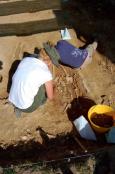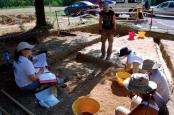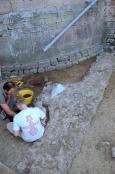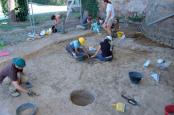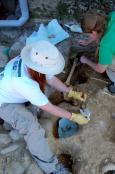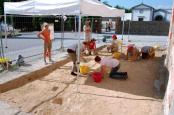CAMPAGNA 2011 |
1° SETTIMANA |
2° SETTIMANA |
3° SETTIMANA |
4° SETTIMANA |
5° SETTIMANA |
6° SETTIMANA |
02 AGOSTO 2011 
Resoconto della giornata di scavo
Area 1000
Dopo la rimozione degli strati US 1017 e US 1013, nella giornata di oggi sono state messe in luce alcune interessanti evidenze. Sono stati individuati tre grandi tagli riempiti da materiale che tradisce un attività recente, forse attribuibile alle ultime opere di ristrutturazione della chiesa. Le buche sono tutte della stessa dimensione ed allineate lungo una traiettoria che circonda il lato E dell’intera struttura. Inoltre la pulizia della cresta di rasatura US 1008 ha permesso di leggerne meglio alcune caratteristiche: si tratta di una colata di malta con inclusi costituiti da ciottoli di fiume e laterizi. La struttura, con andamento E-O, è stata dotata di un contrafforte realizzato con la stessa tecnica. È stato poi rimosso completamente il riempimento US 1022, addossato alla parete E del transetto, al cui interno erano state individuate alcune ossa umane fuori connessione, sicuramente in giacitura secondaria.
We began the day by removing more of layer US
1017 and excavating bone fragments from US 1022. This filling appears to
contain some bones out of connection. We also defined the edges of the walls on
both the north and south portion of the excavation area. While removing layer
US 1017 and US 1013, three dark, round stains became evident on both sides of
the southern wall (US 1008). The fill of these three holes was removed, and
pieces of glass and modern pottery were recovered.
Area 2000
Oggi è stato
possibile documentare e rimuovere parzialmente le Us 2092, un individuo
adulto orientato Est-Ovest e collocato nell’angolo Sud-Ovest dell’area a
ridosso della risega della chiesa, in buono stato di conservazione, e Us
2080, posto nella porzione Sud-Est dell’area ed orientato Nord-Sud,
parzialmente conservato e stravolto a Nord dalla buca US -2025.
Continua la
messa in luce degli altri due individui in connessione individuati nei giorni
scorsi, Us 2075 e Us 2083.
On the south end of area 2000 several femurs were revealed and tomorrow
they will excavate a pelvis. On the north end one individual (Us 2080) is
being removed, one will be dig out first thing tomorrow and another is still in
the process of being revealed.
Area 3000
Nella giornata di oggi si è proceduto alla rimozione dello strato US 3019, un battuto di colore rosso caratterizzato da laterizi sbriciolati, che si estende dal limite meridionale dell’area fino circa al pilastro angolare della facciata della chiesa. Sono stati rinvenuti alcuni chiodi, frammenti di vetro, alcune perline colorate (forse appartenenti ad un rosario), alcuni fermagli in bronzo per gli abiti e ceramica invetriata e da cucina. La rimozione dello strato ha permesso di mettere in evidenza il livello inferiore, che ad una prima analisi sembra essere uguale all’US 3020, uno strato di colore bruno giallastro, piuttosto compatto, a matrice limo-sabbiosa, caratterizzato dalla presenza di ossa sparse. È stato inoltre rimosso lo strato di malta US 3021 che ha portato ad evidenziare, a contatto con la sottostante US 3020, un’area irregolarmente quadrangolare caratterizzata da tracce di fuoco, carbone e scorie frammentarie di metallo in lega di rame.
Today on the 02/08/11 we removed layer 3019 (a
thin layer of red clay material, situated in the south of the area). 3019
contained fragments of glass, metal clasps used for buttoning clothes, buttons,
rusty nails, cooking ceramics and porcelain which are all dated back to the 19th
century.
After removing 3019, we started working on
layer 3021 which is a triangular stain of mortar extended between the angular
plaster and building A. The stain was thin and friable. We found fragments of
glass, cooking ceramics, porcelain, fragments of both human and animal bone, a
black bead and copper slag.
After removing 3019 and 3021 we exposed fully
the layer of 3020. Our first impression
is that the layer, which is under both 3019 and 3021, is contemporary with
those layers and it is characterized with human bones that are fragmented and
not in connection.
Tomorrow we will explore 3020 futher.
Area 4000
Il lavoro della giornata è consistito, nella mattinata, nella rimozione degli ultimi lacerti di US rimossi nei giorni precedenti ed in una pulizia generale dell’area per ottenere una documentazione fotografica generale più ampia e dettagliata. È stato inoltre messo in evidenza il taglio US -4045 ed il suo riempimento US 4044, posti sul lato occidentale dell’area e legati alla posa, in epoca moderna, di un albero. È stato illustrato agli studenti stranieri il metodo del fotoraddrizzamento mediante lo sfruttamento di fotografie aeree e di specifici software. Si è inoltre proceduto all’utilizzo didattico della stazione totale per tutti quegli studenti i quali non hanno mai avuto un approccio diretto con lo strumento. Con queste nozioni di base si è proceduto ad effettuare un rilievo digitale dell’area potendo unire tecniche topografiche, informatiche e fotografiche. Nel pomeriggio è stato completamente rimosso il suddetto riempimento US 4044 mentre una seconda squadra provvedeva alla iniziale rimozione di US 4022, il battuto stradale occupante la quasi totalità dell’area, rilevando al di sotto di esso una nuova paleo superficie (US 4030).
In the morning we cleaned the surfaces of 4022,
the pipe, and the pipe’s surrounding context in preparation for
photographs. We also scraped the surface
of 4044 (fill) and defined the cut (4045).
We took photographs of all the contexts exposed from work done yesterday
and today. We learned how to use the
Total Station to take measurements of the perimeter and the outline of the
contexts so that we will now be able to generate a digital map of our area. Alessandro put down markers at specific
points to use in rectification of the images (done later today); the markers
were the points we measured with the total station.
In the afternoon, we continued to take out the
fill (4044) and follow the cut (-4045).
By the end of the day we had fully exposed the cut. We also exposed a context that is under
4028. This context will be further
examined and described tomorrow. At the
end of the day, we took the measurements generated by the total station and
inputted them into the computer, where we will update the digital map of our
area in GIS.










